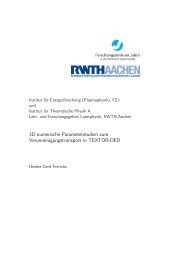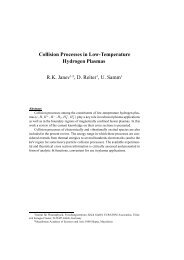The data file AMJUEL: Additional Atomic and Molecular ... - eirene
The data file AMJUEL: Additional Atomic and Molecular ... - eirene
The data file AMJUEL: Additional Atomic and Molecular ... - eirene
Create successful ePaper yourself
Turn your PDF publications into a flip-book with our unique Google optimized e-Paper software.
Types of Data, general prescriptions<br />
H.0: interaction potentials<br />
<strong>The</strong> classical elastic collision kinetics is determined by the interaction potential V (r). In<br />
EIRENE for given (r<strong>and</strong>om sampling) impact parameter b <strong>and</strong> relative collision energy Er (in<br />
eV) the deflection angle χ in the center of mass system is computed <strong>and</strong> the test particle velocity<br />
is then changed accordingly in the laboratory system. <strong>The</strong>re are various options for potential<br />
functions V (r). <strong>The</strong> potential is always in eV, <strong>and</strong> the distance r (<strong>and</strong> also b in EIRENE) are in<br />
(atomic) units of the Bohr radius a0 = 0.529 × 10 −8 cm. <strong>The</strong> parameter FIT-FLAG determines<br />
which particular fit expression is used for the potential. <strong>The</strong> potential V (r) can be specified<br />
then by up to 9 fit coefficients p0, . . . , p8, see Section 0.<br />
FIT-FLAG=<br />
=1 purely repulsive potential: to be written<br />
=2 Morse like potential:<br />
with<br />
with the parameters:<br />
p0 = ϵ (eV)<br />
p1 = g1<br />
p2 = g2<br />
V (r) = ϵ [<br />
e 2g(1−ρ) − 2e g(1−ρ)]<br />
ρ := r/rm ; g :=<br />
{ g1 for ρ < 1<br />
g1g2 for ρ ≥ 1<br />
p3 = rm (in units of a0), the minimum of V (r) : V (rm) = −ϵ<br />
Derived Parameters ( are: )<br />
ln 2<br />
p4 = r0 = rm 1 − , the root of V (r) : V (r0) = 0<br />
g1 ( )<br />
p5 = rw = rm 1 + , the point of inflection of V (r)<br />
p6 not in use<br />
p7 = V (rw) = − 3ϵ<br />
4<br />
p8 not in use<br />
ln 2<br />
g1g2<br />
H.1: cross section vs. energy<br />
Fits for σ(Elab,1) [cm 2 ]<br />
Collision cross are functions of relative velocity, but, due to historic reasons in the EIRENE<br />
<strong>data</strong>bases, which initially had been build on <strong>data</strong> of ref. [2], the laboratory energy of one of<br />
the colliding particles (usually the charged particle) is used, with the second collision partner<br />
(usually the neutral particle) being at rest. I.e., σ = σ(Elab,1). To convert to center of mass<br />
energies, one uses Elab,1 = m1/2 v 2 1 <strong>and</strong> ECM = µ/2 v 2 rel with µ = m1m2/(m1 + m2) being<br />
the reduced mass <strong>and</strong> vrel = |v1 − v2| the relative collision velocity<br />
H.2: rate coefficients vs. temperature (zero beam energy)<br />
Fits for ⟨σ · v⟩(Tp) [cm 3 /s]<br />
25<br />
(1)<br />
(2)




